Do you want to improve as a baseball player? Then you must know about portable pitching mounds and accurate pitching mound dimensions.
But did you know that its size must adhere to strict rules that vary by league and by level of play? Knowing the rules can make or break a baseball club at any level, from the Majors to Little League.
In this article, I’ll discuss the significance of pitching mound dimensions and review all the details you need to know. You will also learn how to measure various mound types precisely. So grab your glove, and let’s get pitching!
The History of Pitching Mounds
There was no designated pitching mound at the beginning of MLB. Instead, they delivered their throws from a ground-level pitcher’s box.
But in 1893, the game changed when an elevated pitching rubber was introduced, allowing pitchers to throw at higher speeds and giving them an edge over batters.
However, during this time, there were no regulations on mound height. The height and incline varied from one game to the next, determined by the home team’s groundskeeper.
This put visiting teams at a disadvantage since they had little time to adjust to the specific mound size of their opponents.
It wasn’t until 1903 that MLB established official guidelines for pitchers’ mounds. Under these new rules, pitching mounds had to be at least 15 inches high and no more than 10 inches above home plate level.
This was done to give pitchers a better advantage over hitters by allowing them to throw from a higher vantage point.
In 1950, another change came about when MLB revised its rule book once again for pitching mound dimensions.
The slope of the pitcher’s mound could not exceed one inch per every foot in the distance toward home plate under this new regulation.
Today, accurate measurements are critical for all aspects of modern baseball – including pitching mounds – as players need consistency across different fields, regardless if it is major league or youth leagues such as Little League Baseball (LLB).
Major League Baseball (MLB) Regulations
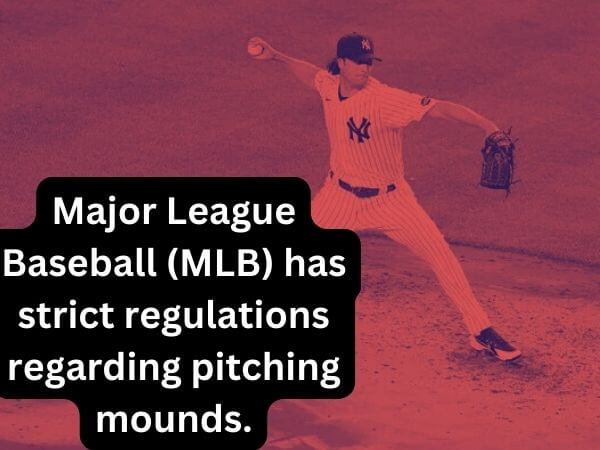
Major League Baseball (MLB) has strict regulations regarding pitching mounds.
The mound must be a raised area 18 feet in diameter with the center of the pitcher’s rubber 60 feet, 6 inches from home plate.
The top of the pitching rubber should be no higher than 10 inches above the home plate.
The slope of the mound is also regulated by MLB. From its highest point at the pitcher’s plate to its lowest point at ground level, the slope should measure one inch per foot horizontally and one vertical foot for every three horizontal feet.
These regulations are in place to ensure fair play and prevent any team from gaining an unfair advantage over another. Pitchers rely heavily on consistency, so having a standard size and shape for all pitching mounds across MLB ensures that each game is played under similar circumstances.
Minor League Baseball (MiLB) Regulations
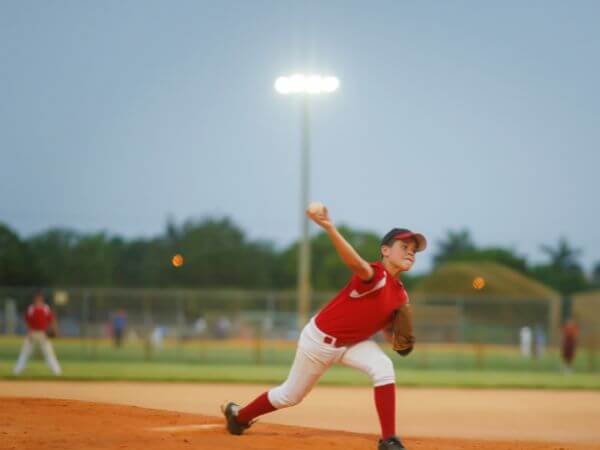
Minor League Baseball (MiLB) Regulations are similar to those of Major League Baseball (MLB), with a few differences.
The pitching mound on a MiLB field must be 10 inches high, while the distance from the pitcher’s rubber to home plate is 60 feet and six inches.
Unlike MLB, MiLB allows for variations in pitching mound dimensions between different levels of play.
For example, Single-A teams can have a smaller pitching mound than Triple-A teams. This flexibility allows organizations to adjust their fields according to player development needs.
Additionally, MiLB has regulations regarding what kind of material should be used for constructing the pitching mound. According to their guidelines, it should consist of clay or other suitable materials that provide good footing and prevent slipping.
Complying with these regulations ensures that players are playing on fields that meet industry standards and provides consistency across all minor league venues.
Little League Baseball (LLB) Regulations
Little League Baseball (LLB) is a youth baseball organization that was founded in 1939. It has since grown into the world’s largest organized youth sports program, with over two million players worldwide.
The pitching mound dimensions for Little League Baseball are regulated by the organization and vary depending on the age group of the players.
For ages, 8-10 years old, the distance from home plate to the pitcher’s rubber is 46 feet, while for ages 11-12 years old it is increased to 50 feet.
The height of the pitching mound must also be at least 6 inches above home plate and its radius must be 10 feet.
These regulations ensure that all players have an equal opportunity to pitch and develop their skills within appropriate parameters.
In addition to regulating pitching mound dimensions, LLB also has guidelines regarding batting helmets, catcher equipment, fielding gloves, and uniforms for its young athletes.
These regulations serve as a guide for coaches and parents alike in ensuring fair play and safety for all participants in Little League Baseball games.
NCAA Regulations
The National Collegiate Athletic Association (NCAA) has specific regulations regarding the dimensions of pitching mounds used in college baseball.
All teams will be competing on an equal playing field. The NCAA specifies that the pitcher’s plate must be 10 inches higher than the home plate.
There should be exactly 60 feet and six inches between the front border of the pitcher’s plate and the back point of the home plate.
In addition, the NCAA requires a minimum slope of one inch every foot, or six feet, from the mound to home plate.
This means that if your portable or game mound is not able to meet these specifications – it cannot be used during an NCAA-sanctioned game.
College baseball programs need to adhere strictly to these guidelines when building or purchasing their pitching mounds. Failure to do so could result in disqualification from games or other penalties imposed by the NCAA.
Understanding and following NCAA regulations ensures fair play for all teams while promoting safety and consistency throughout collegiate baseball games.
Why You Need a Portable Pitching Mound

A portable pitching mound is a great investment for any baseball team or pitcher, whether you’re playing in a league or just practicing on your own. Here are some reasons why you need one:
Firstly, with a portable pitching mound, you can practice anywhere.
You no longer have to rely on finding an appropriate field or paying expensive rental fees at an indoor facility – simply set up the mound wherever you want and start throwing.
Secondly, using a portable pitching mound allows pitchers to practice game-like conditions.
The raised surface of the mound allows pitchers to work on their stride length and mechanics without having to adjust every time they change locations.
Thirdly, by owning your own pitching mound, you ensure that it meets regulation size requirements.
This means that when it comes time for games or competitions, you’ll be able to perform at your best without having to worry about adjusting to different mounds.
Investing in a high-quality portable pitching mound will save money over time as there’s no need for costly repairs like traditional ground-built mounds require.
It may also last longer than other types of mounds because it is designed for mobility and ease of use which ensures long-term durability and performance quality.
Different Types of Pitching Mounds and Their Dimensions
Pitching mounds come in different types and sizes, each designed to suit a specific purpose or level of play.
One common type is the game pitching mound used for official games. Another type of pitching mound is the indoor practice mound, which comes in various sizes ranging from smaller ones meant for young players to larger ones suitable for professionals.
Pitching platforms are another option that can be used for both indoor and outdoor training sessions.
They do not have a slope like regular mounds but provide a flat surface that mimics the pitcher’s stride length.
Game Pitching Mounds
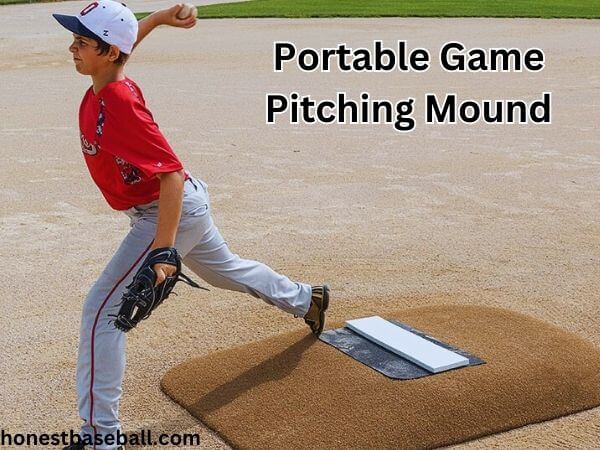
Game mounds are used to host games and competitions, which is their clear purpose. Game mounds can be moved around and are usually only used outside. Most of the time, this means that the turf has been coated with a UV-resistant coating treatment to make it last longer.
The size of the game’s pitching mounds depends on the player’s age and skill level.
It’s important to know that there is also portable game pitching mounds for teams that need to use different fields or practice spots often.
With these portable choices, coaches can give their players a real playing experience wherever they practice or compete.
When picking a game pitching mound, it’s important to think about how it’s built and how long it will last. Look for materials that won’t break down over time even if they are used a lot.
Why Do I Need a Portable Game Pitching Mound?
As a player, you must have access to a portable game pitching mound. These mounds are specially designed for baseball games, and what is better than practicing on a real game mound?
A portable game pitching mound can be used in various settings, which is one of its key benefits.
It works just as well on dirt fields as it does on grass or turf.
This means that your squad can count on a uniform playing field everywhere they travel.
Convenience is another advantage. Portable pitching mounds for games require little time or effort to set up for the coaches and players.
They don’t require any special tools or equipment to assemble and disassemble.
Furthermore, using a portable game pitching mound helps protect real mounds from damage caused by excessive use during games and practices.
Indoor Practice Pitching Mounds
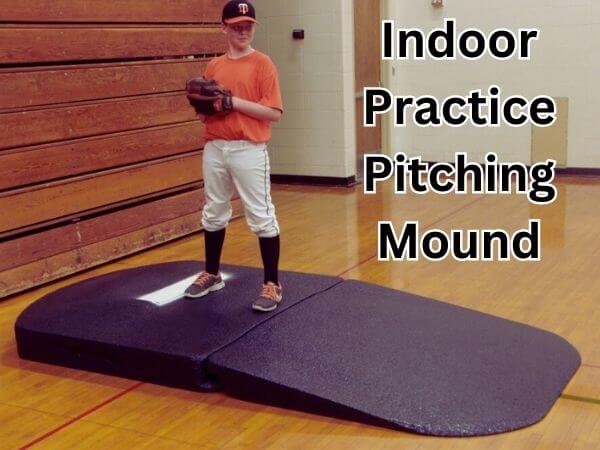
Indoor practice pitching mounds are becoming more and more popular among baseball players due to their convenience. With unpredictable weather conditions, a portable indoor pitching mound is great for practicing indoors during rain or snow.
These types of pitching mounds come in various sizes and shapes, but the most common dimensions are 4 feet wide by 8 feet long with a height of either 6 inches or 10 inches.
The smaller size is perfect for younger players, while the larger one suits high school and college athletes.
Pitching off an indoor mound helps develop muscle memory as it provides stability during repetitive throwing drills. It also allows pitchers to focus on their footwork without worrying about slipping on wet grass or uneven terrain.
When choosing an indoor practice pitching mound, look for ones that have durable materials, such as reinforced fiberglass or sturdy foam cores. Also, consider its portability and ease of storage when not in use.
Whether you’re prepping for tryouts or just looking to improve your skills, investing in an indoor practice pitching mound can be a game-changer.
Pitching Platforms
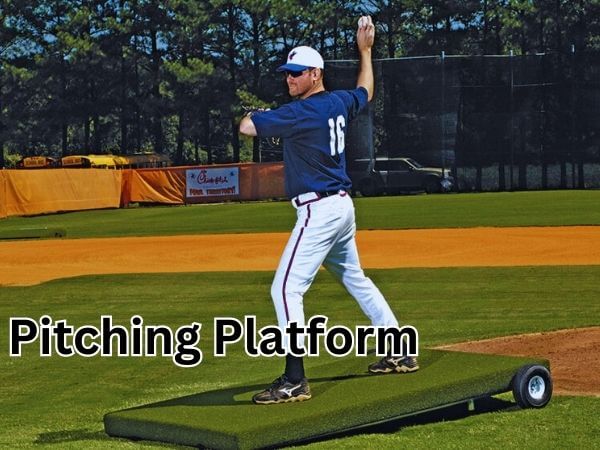
For indoor practice sessions, pitching platforms are a terrific alternative. These platforms come with the property of both indoor practice and game pitching mounds.
They offer a reliable and constant surface for pitchers to practice on throughout the year. These surfaces can sustain heavy foot traffic since they are constructed from rubber or artificial turf.
As an added bonus, pitching platforms can be easily moved from one location to another. They are portable so that coaches and players can use them wherever. Wheels are standard equipment on most pitching platforms.
Pitching platforms are available in various sizes, from those best suited for younger players to those more appropriate for more experienced players. The age and ability level of the player should guide your selection of the correct size.
Different Mound Sizes for Different Age Levels and Leagues
Pitching mounds come in different sizes to accommodate the varying needs of different age levels and leagues. The size of the mound is crucial as it can affect a pitcher’s performance on the field.
4 to 5” Pitching Mounds for 4 to 7 Years Age Group
Smaller pitching mounds are appropriate for younger players in T-ball and coach pitch leagues. These are usually between 2 and 3 feet in length and 4 to 6 inches in height. Mini-mounds, smaller pitching mounds that can be moved about the field, are also common among players of these ages.
6” Pitching Mounds for U11 League
As players advance to higher levels, such as Little League and Pony League baseball, they will need larger pitching mounds. These usually have dimensions of 6 inches high with a slope between 10-18 feet long.
8” Pitching Mounds for 12-14 Age Group
Though not that popular, these age groups should use this size of pitching mound.
10” Pitching Mounds for High School and Adults
High school and college-level pitchers require even larger pitching mounds measuring at least 10 inches high with slopes ranging from 16-20 feet long. Pitchers at this level need more space to generate enough power and velocity for their pitches.
How to Measure a Pitching Mound
You MUST know the exact dimensions needed for the mound, as they can change based on the league or level of play.
You’ll need a tape measure and something to set up markings at regular intervals before you can begin measuring the pitching mound.
Standing at the back of the pitcher’s plate, the distance to home plate is 60 feet, 6 inches. Here is where you should put the middle of your pitching rubber.
Next, measure from side-to-side across the top of the pitcher’s plate to determine its width. In most cases, this should be around 24 inches wide but may vary based on league regulations.
From there, use your tape measure to find out how high above ground level you need to build up your pitching surface. The height typically ranges from 10-12 inches for standard mounds in various leagues.
Once these measurements have been made, it’s important to double-check them before constructing or purchasing a new pitching mound. Any slight variations can cause significant changes in performance and accuracy during gameplay.
Important note about pitching mounds for youth leagues
The size of the pitching mound you buy is important, but that doesn’t guarantee it will be okay for usage in games and tournaments in your league.
Any mound used in a Little League game or competition must meet Little League specifications. This means that the Little League organization must officially sanction the usage of that particular mound prior to its use in a game.
Therefore, the pitching mound MUST meet the proper regulations and dimensions for players of a certain age range. Little League Baseball (LLB) has specific guidelines for approved pitching mounds that must be followed.
According to LLB rules, the pitching mound height must be no higher than six inches, with a slope of one inch per foot for distances between 38-50 feet. For distances over 50 feet, there should be a maximum slope of 3/4 inch per foot.
It’s important to note that using an unapproved or incorrectly sized pitching mound can lead to not only injury but also disqualification from games and tournaments.
Pitching Mound Construction and Durability
Pitching mound construction and durability are important factors to consider when building your own pitching mound. The materials used in the construction of a pitching mound can significantly affect its longevity, stability, and overall performance.
One popular material used for constructing pitching mounds is clay. Clay provides excellent traction for pitchers but requires regular maintenance to avoid cracking or erosion. Other options include rubber or synthetic turf, which may require less maintenance but may not provide the same level of grip as natural clay.
Proper construction techniques are essential to ensure the pitching mound’s stability regardless of the material utilized. Water should not collect around a pitching mound. Therefore, make sure its foundation has good drainage.
Pitching Mound Warranties – How Long is Long Enough?
It’s smart to check the pitching mound’s warranty before purchasing. Manufacturer warranties may or may not cover certain components of a product.
For example, a one-year warranty may only cover manufacturing or material problems. Some policies may provide more extensive coverage or for longer time periods.
Before making a purchase, it’s in your best interest to study the warranty in detail to learn exactly what is and isn’t covered.
Keep in mind that warranties typically only apply if the product is used according to its intended purpose.
Pitching Mound Color – What color should we pick
When it comes to selecting the color of your pitching mound, there are a few things to consider. While some may think aesthetics should be the sole determining factor, there are other important considerations.
First and foremost is visibility. The pitcher’s landing area must be clearly visible to both batters and fielders. A brightly colored mound can also help players see where they need to step while in motion.
Another consideration is temperature control. Darker colors will absorb more heat from the sun, making them hotter than lighter colors. This can affect not only player comfort but also potentially impact performance.
If you are planning to buy a pitching mound for under USD 100, you can check this blog Best Portable Pitching Mound under $100
What Factors to Consider When Building a Pitching Mound
So, are you prepared to make build your own pitching mound?
The pitcher’s landing area soil type, as well as mound slope, are important considerations. Soil should be firm enough to provide traction, yet soft enough to absorb impact energy.
Whether you’re constructing a game or practicing a mound, selecting the appropriate dimensions is another critical step.
The pitching mound used in a game must adhere to the rules established by your league. Height, incline angle, radius, and width all need to be accurately measured.
Consideration of drainage and irrigation systems is also necessary for maintaining a dry surface during wet periods.
Proper maintenance practices like watering regularly, filling holes with clay, and leveling high spots can help keep your pitching mound in good condition.
If you want to make a pitching mound all by yourself, here is a step-by-step guide here – How To Build A Round Portable Pitching Mound
Maintenance & Care of Your Pitching Mound
Maintaining and caring for your pitching mound is crucial to ensure its longevity and optimal performance. Regular maintenance includes removing debris, repairing any damages, leveling the surface, and ensuring proper moisture levels.
To prevent excessive wear and tear on the mound, limit its use to only pitchers during games or practices. Avoid using it as a general playing area or trampling on it with heavy equipment.
During offseasons or extended periods of inactivity, covering the mound with a tarp can protect it from weather damage. Be sure to remove the tarp periodically to allow for proper ventilation.
In terms of care, avoid using harsh chemicals or cleaning agents that could potentially damage the material composition of the pitching mound. Instead, opt for gentle cleaners specifically designed for synthetic turf surfaces.
By following these recommended maintenance and care practices, you can help extend the life of your pitching mound and optimize its performance for years to come.
Final Words
Knowing the dimensions of a pitching mound can help you understand how the game is played, and why it’s so important for pitchers to have good control.
The size and shape of the mound also have an effect on pitcher performance – taller mounds allow for more speed, while shorter ones make breaking pitches harder to throw.
Whether you’re watching a professional game or playing in your own backyard, understanding these measurements will give you insight into why pitching is such an essential part of baseball.
More Resources
Are Pitching Machines Good For Batting Practice?
How To Increase Pitching Velocity By 10 MPH
How to Start Practicing Pitching Alone?
How to Improve Softball Pitching Accuracy?

Hello everyone. My name is Jason Butler, and I live in California, America. I was a professional AAA Minor League Baseball player. I lost my chance of playing MLB for injury issues, but I did not lose my love for baseball. I attended the coaching training program and am now working as a coach in a small school in San Diego.
I always love to share my experience and knowledge if that can help you. Play baseball, and stay fit.
